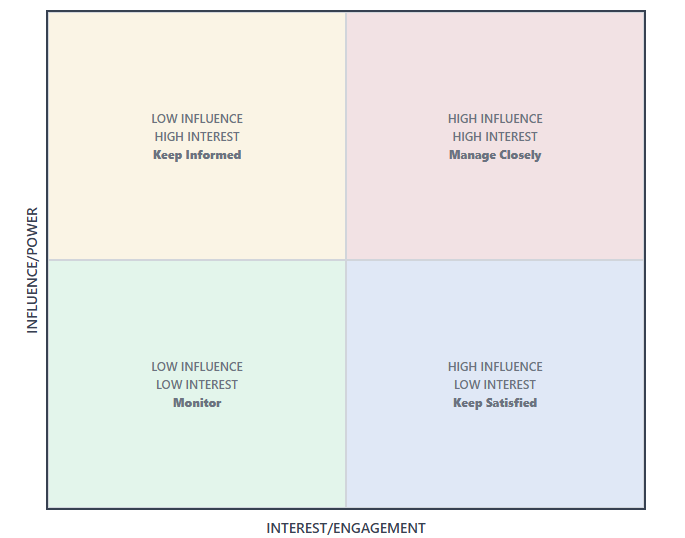Now Reading: Power–Interest Grid for Stakeholder Analysis: How to Use It Effectively
-
01
Power–Interest Grid for Stakeholder Analysis: How to Use It Effectively
Power–Interest Grid for Stakeholder Analysis: How to Use It Effectively
What Is the Power–Interest Grid?

It is a simple yet powerful model for analyzing stakeholders. It helps project teams categorize stakeholders based on two factors:
- Power/ Inference – their ability to influence decisions or outcomes.
- Interest – their level of involvement or concern about the project.
By placing stakeholders on a 2×2 grid, you can see at a glance who to prioritize, who to keep informed, and who requires minimal effort.
The Four Quadrants Explained
Low Power – High Interest (Keep Informed)
They may not have decision-making power, but they care about outcomes. Keeping them informed prevents resistance.
Example: End-users who will adopt the new system once it is launched.
High Power – High Interest (Manage Closely)
These stakeholders can make or break your project. They need regular updates, direct involvement, and strong relationships.
Example: A project sponsor funding the initiative.
Low Power – Low Interest (Monitor)
These stakeholders require minimal effort. Provide occasional updates but do not overwhelm them.
Example: External observers or regulatory staff with minor involvement.
High Power – Low Interest (Keep Satisfied)
They have influence but may not want to be deeply involved. Keep them satisfied with concise, high-level updates.
Example: A senior executive not directly involved but whose department may be affected.
Why the Power–Interest Grid Important
- Prioritizes resources: You focus your energy on the right people.
- Reduces conflict: Engagement strategies prevent misalignment.
- Supports communication planning: Each quadrant has a clear approach.
- Improves project success: When stakeholders feel valued, cooperation increases.
How the Tool Automates This Process
Traditionally, teams sketch the grid manually. But with the Stakeholder Management Tool, the process becomes seamless:
- Add stakeholders with their power and interest levels.
- The tool automatically assigns an engagement strategy for each quadrant.
- Engagement strategies (e.g., Manage Closely, Keep Informed) are generated in real-time, so there is no guesswork.
- Results are stored alongside your communication plan, risks, and action log for easy tracking.
This automation not only saves time but ensures consistency across projects.
A stakeholder management plan is not just paperwork—it is a roadmap for building strong relationships that drive projects to success. By identifying the right people, engaging them effectively, and monitoring progress, you reduce risks and improve collaboration.
With a dedicated tool, creating and maintaining this plan becomes far easier, giving project teams the clarity and confidence to focus on execution.

